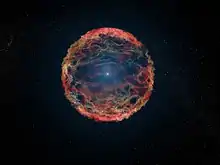 | |
| Event type | Supernova |
|---|---|
| SN.IIb | |
| Constellation | Ursa Major |
| Right ascension | 09h 55m 24.77476s[1] |
| Declination | +69° 01′ 13.7026″[1] |
| Epoch | J2000 |
| Peak apparent magnitude | +10.7[2] |
| Other designations | SN 1993J, AAVSO 0947+69, ICRF J095524.7+690113, INTREF 395, PBC J0955.1+6904 |

SN 1993J is a supernova observed in the galaxy M81. It was discovered on 28 March 1993 by F. Garcia in Spain.[3] At the time, it was the second-brightest type II supernova observed in the twentieth century behind SN 1987A,[4] peaking at a visible apparent magnitude of 10.7 on March 30, with a second peak of 10.86 on April 18.[2]
The spectral characteristics of the supernova changed over time. Initially, it looked more like a type II supernova (a supernova formed by the explosion of a giant star) with strong hydrogen spectral line emission, but later the hydrogen lines faded and strong helium spectral lines appeared, making the supernova look more like a type Ib.[4][5] Moreover, the variations in SN 1993J's luminosity over time were not like the variations observed in other type II supernovae[6][2] but did resemble the variations observed in type Ib supernovae.[7] Hence, the supernova has been classified as a type IIb supernova, an intermediate class between type II and type Ib.[5] The scientific results from this supernova suggested that type Ib and Ic supernovae were actually formed through the explosions of giant stars through processes similar to what takes place in type II supernovae.[5][8] The supernova was also used to estimate a distance of 8.5 ± 1.3 Mly (2.6 ± 0.4 Mpc) to Messier 81.[4]
Light echoes from the explosion have subsequently been detected. [9]
The progenitor of SN 1993J was identified in pre-explosion ground-based images.[10] The progenitor was observed to be a K-type supergiant star, with an excess in the ultraviolet possibly due to surrounding hot stars or a hot binary companion. While the supernova is located in a region populated by young massive stars,[11] late-time photometry with the Hubble Space Telescope and spectroscopy with the Keck 10m-telescope presented by Maund and collaborators revealed the presence of the long-suspected B-supergiant companion star.[12]
References
- 1 2 "SN 1993J". SIMBAD. Centre de données astronomiques de Strasbourg. Retrieved 2021-01-25.
- 1 2 3 J. C. Wheeler; E. Barker; R. Benjamin; J. Boisseau; A. Clocchiatti; G. de Vaucouleurs; N. Gaffney; R. P. Harkness; A. M. Khokhlov; D. F. Lester; B. J. Smith; V. V. Smith; J. Tomkin (1993). "Early Observations of SN 1993J in M81 at McDonald Observatory". Astrophysical Journal. 417: L71–L74. Bibcode:1993ApJ...417L..71W. doi:10.1086/187097.
- ↑ J. Ripero; F. Garcia; D. Rodriguez; P. Pujol; A. V. Filippenko; R. R. Treffers; Y. Paik; M. Davis; D. Schlegel; et al. (1993). "Supernova 1993J in NGC 3031". IAU Circular. 5731: 1. Bibcode:1993IAUC.5731....1R.
- 1 2 3 Schmidt, B.P.; Kirshner, R.P.; Eastman, R.G.; Grashuis, R.; Dell'Antonio, I.; Caldwell, N.; Foltz, C.; Huchra; Milone (1993). "The unusual supernova SN1993J in the galaxy M81". Nature. 364 (6438): 600–602. Bibcode:1993Natur.364..600S. doi:10.1038/364600a0. S2CID 4304547.
- 1 2 3 A. V. Filippenko; T. Matheson; L. C. Ho (1993). "The "Type IIb" Supernova 1993J in M81: A Close Relative of Type Ib Supernovae". Astrophysical Journal Letters. 415: L103–L106. Bibcode:1993ApJ...415L.103F. doi:10.1086/187043.
- ↑ P. J. Benson; W. Herbst; J. J> Salzer; G. Vinton; G. J. Hanson; S. J. Ratcliff; P. F. Winkler; D. M. Elmegreen; F. Chromey; C. Strom; T. J. Balonek; B. G. Elmegreen (1994). "Light curves of SN 1993J from the Keck Northeast Astronomy Consortium". Astronomical Journal. 107: 1453–1460. Bibcode:1994AJ....107.1453B. doi:10.1086/116958.
- ↑ M. W. Richmond; R. R. Treffers; A. V. Filippenko; Y. Palik; B. Leibundgut; E. Schulman; C. V. Cox (1994). "UBVRI photometry of SN 1993J in M81: The first 120 days". Astronomical Journal. 107: 1022–1040. Bibcode:1994AJ....107.1022R. doi:10.1086/116915.
- ↑ A. V. Filippenko; T. Matheson; A. J. Barth (1994). "The peculiar type II supernova 1993J in M81: Transition to the nebular phase". Astronomical Journal. 108: 2220–2225. Bibcode:1994AJ....108.2220F. doi:10.1086/117234.
- ↑ Sugerman, Ben & Crotts, Arlin (November 8, 2002). "Multiple Light Echoes from Supernova 1993J". The Astrophysical Journal. 581 (2): L97–L100. arXiv:astro-ph/0207497. Bibcode:2002ApJ...581L..97S. doi:10.1086/346016. S2CID 118152671.
- ↑ Aldering, G.; R. Humphreys; M. Richmond (1994). "SN 1993J: The optical properties of its progenitor". Astronomical Journal. 107: 662. Bibcode:1994AJ....107..662A. doi:10.1086/116886.
- ↑ Van Dyk, S.D.; P.M. Garnavich; A.V. Filippenko; P.A. Hoflich; R.P. Kirshner; R.L. Kurucz; P. Challis (2002). "The Progenitor of Supernova 1993J Revisited". Publications of the Astronomical Society of the Pacific. 114 (802): 1322. arXiv:astro-ph/0208382. Bibcode:2002PASP..114.1322V. doi:10.1086/344382. S2CID 14476023.
- ↑ Maund, J.; S.J. Smartt; R.P. Kudritzki; P. Podsiadlowski; G.F. Gilmore (2004). "The massive binary companion star to the progenitor of supernova 1993J". Nature. 427 (6970): 129–31. arXiv:astro-ph/0401090. Bibcode:2004Natur.427..129M. doi:10.1038/nature02161. PMID 14712269. S2CID 4413401.